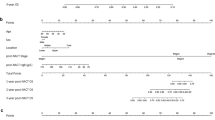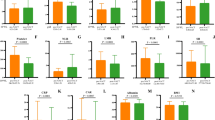Abstract
Purpose
Chemotherapy for end-of-life ovarian cancer patients is a complex and delicate problem. We evaluated whether active palliative chemotherapy is beneficial for such patients using inflammatory parameters, nutritional indicators, and the PPI (Palliative Prognostic Index), which predicts short-term prognosis.
Methods
Thirty-six patients among 49 patients who died from ovarian cancer from 2014 to 2019 at our hospital were enrolled, whom clinical and laboratory data just before starting their final chemotherapy regimen could be obtained. Associations between the time from last chemotherapy to death and the following parameters were investigated: age, performance status, neutrophil/lymphocyte ratio (NLR), platelet/lymphocyte ratio, Modified Glasgow Prognostic Score (mGPS), Prognostic Nutritional Index (PNI) score, and PPI score.
Results
The median age was 57 (range 19–80) years. The median time from last chemotherapy to death was 45.5 (range 11–110) days. Eight patients (22%) died within 30 days of their last chemotherapy regimen. In univariate analysis, median survival time was significantly shorter in patients with higher NLR, mGPS 2, and higher PPI values; NLR (≥ median vs. < median): 32 (range 11–80) days vs. 54 (range 35–110) days, p = 0.008; mGPS (2 vs. 0–1): 42 (range 11–80) days vs. 96 (range 49–110) days, p = 0.012; and PPI score (≥ median vs. < median): 38 (range 11–74) days vs. 60 (range 18–110) days, p = 0.005. However, in multivariate analysis, no factors were identified as independent prognostic factors for survival.
Conclusion
Parameters, such as NLR, mGPS, and PPI score, may be indicators for discontinuation of palliative chemotherapy, and may be useful for maximizing end-of-life care for ovarian cancer patients.




Similar content being viewed by others
References
Roncolato FT, Berton-Rigaud D, O’Connell R, Lanceley A, Sehouli J, Buizen L et al (2018) Validation of the modified Glasgow Prognostic Score (mGPS) in recurrent ovarian cancer (ROC)—analysis of patients enrolled in the GCIG Symptom Benefit Study (SBS). Gynecol Oncol 148(1):36–41
Futagami M, Yokoyama Y, Sato T, Hirota K, Shimada M, Miyagi E et al (2016) Palliative care for patients with gynecologic cancer in Japan: a Japan Society of Gynecologic Palliative Medicine (JSGPM) Survey. Asian Pac J Cancer Prev 17(10):4637–4642
Palaia I, Tomao F, Santangelo G, Di Pinto A, Sassu CM, Perniola G et al (2019) The EOLO (End-of-Life Ovarian Cancer) study: approach to ovarian cancer patients at the end of life. Oncology 97(5):306–310
Temel JS, Shaw AT, Greer JA (2016) Challenge of prognostic uncertainty in the modern era of cancer therapeutics. J Clin Oncol 34(30):3605–3608
Milnes S, Corke C, Orford NR, Bailey M, Savulescu J, Wilkinson D (2019) Patient values informing medical treatment: a pilot community and advance care planning survey. BMJ Support Palliat Care 9(3):e23
Cook C (2009) Is clinical gestalt good enough? J Man Manip Ther 17(1):6–7
Perez-Cruz PE, Dos Santos R, Silva TB, Crovador CS, Nascimento MS, Hall S et al (2014) Longitudinal temporal and probabilistic prediction of survival in a cohort of patients with advanced cancer. J Pain Symptom Manag 48(5):875–882
Hui D, Kilgore K, Nguyen L, Hall S, Fajardo J, Cox-Miller TP et al (2011) The accuracy of probabilistic versus temporal clinician prediction of survival for patients with advanced cancer: a preliminary report. Oncologist 16(11):1642–1648
Christakis NA, Lamont EB (2000) Extent and determinants of error in doctors’ prognoses in terminally ill patients: prospective cohort study. BMJ 320(7233):469–472
Farinholt P, Park M, Guo Y, Bruera E, Hui D (2018) A comparison of the accuracy of clinician prediction of survival versus the Palliative Prognostic Index. J Pain Symptom Manag 55(3):792–797
Gramling R, Fiscella K, Xing G, Hoerger M, Duberstein P, Plumb S et al (2016) Determinants of patient-oncologist prognostic discordance in advanced cancer. JAMA Oncol 2(11):1421–1426
Yin X, Wu L, Yang H, Yang H (2019) Prognostic significance of neutrophil-lymphocyte ratio (NLR) in patients with ovarian cancer: a systematic review and meta-analysis. Medicine (Baltimore) 98(45):e17475
Zhu Y, Zhou S, Liu Y, Zhai L, Sun X (2018) Prognostic value of systemic inflammatory markers in ovarian Cancer: a PRISMA-compliant meta-analysis and systematic review. BMC Cancer 18(1):443
Nakamura K, Nagasaka T, Nishida T, Haruma T, Ogawa C, Kusumoto T et al (2016) Neutrophil to lymphocyte ratio in the pre-treatment phase of final-line chemotherapy predicts the outcome of patients with recurrent ovarian cancer. Oncol Lett 11(6):3975–3981
Zhang W, Ye B, Liang W, Ren Y (2017) Preoperative prognostic nutritional index is a powerful predictor of prognosis in patients with stage III ovarian cancer. Sci Rep 7(1):9548
Komura N, Mabuchi S, Yokoi E, Shimura K, Kawano M, Matsumoto Y et al (2019) Prognostic significance of the pretreatment prognostic nutritional index in patients with epithelial ovarian cancer. Oncotarget 10(38):3605–3613
Anderson F, Downing GM, Hill J, Casorso L, Lerch N (1996) Palliative performance scale (PPS): a new tool. J Palliat Care 12(1):5–11
Morita T, Tsunoda J, Inoue S, Chihara S (1999) The Palliative Prognostic Index: a scoring system for survival prediction of terminally ill cancer patients. Support Care Cancer 7(3):128–133
Maltoni M, Nanni O, Pirovano M, Scarpi E, Indelli M, Martini C et al (1999) Successful validation of the palliative prognostic score in terminally ill cancer patients. Italian Multicenter Study Group on Palliative Care. J Pain Symptom Manag 17(4):240–247
Chuang RB, Hu WY, Chiu TY, Chen CY (2004) Prediction of survival in terminal cancer patients in Taiwan: constructing a prognostic scale. J Pain Symptom Manag 28(2):115–122
Hyodo I, Morita T, Adachi I, Shima Y, Yoshizawa A, Hiraga K (2010) Development of a predicting tool for survival of terminally ill cancer patients. Jpn J Clin Oncol 40(5):442–448
Gwilliam B, Keeley V, Todd C, Gittins M, Roberts C, Kelly L et al (2012) Development of Prognosis in Palliative care Study (PiPS) predictor models to improve prognostication in advanced cancer: prospective cohort study. BMJ Support Palliat Care 2(1):63–71
Aaronson NK, Ahmedzai S, Bergman B, Bullinger M, Cull A, Duez NJ et al (1993) The European Organization for Research and Treatment of Cancer QLQ-C30: a quality-of-life instrument for use in international clinical trials in oncology. J Natl Cancer Inst 85(5):365–376
Greimel E, Bottomley A, Cull A, Waldenstrom AC, Arraras J, Chauvenet L et al (2003) An international field study of the reliability and validity of a disease-specific questionnaire module (the QLQ-OV28) in assessing the quality of life of patients with ovarian cancer. Eur J Cancer 39(10):1402–1408
White N, Reid F, Harris A, Harries P, Stone P (2016) A systematic review of predictions of survival in palliative care: how accurate are clinicians and who are the experts? PLoS ONE 11(8):e0161407
Stone CA, Tiernan E, Dooley BA (2008) Prospective validation of the Palliative Prognostic Index in patients with cancer. J Pain Symptom Manag 35:617–622
Yoong J, Atkin N, Le B (2010) Use of the palliative prognostic index in a palliative care consultation service in Melbourne, Australia. J Pain Symptom Manag 39:e2-4
Stiel S, Bertram L, Neuhaus S, Nauck F, Ostgathe C, Elsner F et al (2010) Evaluation and comparison of two prognostic scores and the physicians’ estimate of survival in terminally ill patients. Support Care Cancer 18:43–49
Chou WC, Kao CY, Wang PN, Chang H, Wang HM, Chang PH et al (2015) The application of the palliative prognostic index, Charlson comorbidity index, and Glasgow prognostic score in predicting the life expectancy of patients with hematologic malignancies under palliative care. BMC Palliat Care 14:18
Author information
Authors and Affiliations
Contributions
KK; data collection and drafting of the manuscript and first author. KH; corresponding author, supervision. MW; acquisition of data, especially clinical data and course. EM; acquisition of data, especially clinical data and course. NK; acquisition of data, especially clinical data and course. IF; supervision throughout this manuscript.
Corresponding author
Ethics declarations
Conflict of interest
We declare that we have no conflict of interest.
Ethical approval
The study protocol was approved by the institutional ethical committee of Dokkyo Medical University. All procedures performed in this study were in accordance with the ethical standards of the institutional ethical committee and with the 1964 Helsinki declaration and its later amendments or comparable ethical standards. This article does not contain any studies with animals performed by any of the authors.
Informed consent
This study was approved by the institutional ethical committee of Dokkyo Medical University, and written informed consents was waived because of retrospective design. This policy was accepted by the institutional ethical committee on the condition that a document that declares an opt-out policy by which any patients' relatives could refuse to be included in this study was uploaded on the Web page.
Additional information
Publisher's Note
Springer Nature remains neutral with regard to jurisdictional claims in published maps and institutional affiliations.
Rights and permissions
About this article
Cite this article
Kiuchi, K., Hasegawa, K., Watanabe, M. et al. Clinical indicators useful in decision-making about palliative chemotherapy for end-of-life ovarian cancer patients. Arch Gynecol Obstet 305, 425–430 (2022). https://doi.org/10.1007/s00404-021-06162-z
Received:
Accepted:
Published:
Issue Date:
DOI: https://doi.org/10.1007/s00404-021-06162-z




